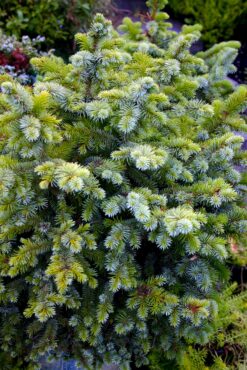
Everyone who lives in Washington knows the official nickname “The Evergreen State” comes from an abundance of evergreen fir, spruce, cedar and pine trees that grow within its borders. Another nickname, “The Green Tree State,” also comes from a plenitude of shrubs and trees with broad-leaf and coniferous, all-season, green foliage.
Our state motto, “Alki,” a Chinook word for “bye and bye” or “hope for the future,” fits right in with planting conifers. We grow for the future. Because the oldest trees in the world are conifers, a thousand years is not very old for many of them. Some can pack the entire European history, starting with ancient Greece, into their life spans.
From Northern California and up into British Columbia, West Coast claims to grow some of the tallest trees in the world. Most of these giants grow in the rainforest on the Olympic Peninsula. Near Kalaloch, a western red cedar (Thuja plicata) tops out at 174 feet, the tallest western red cedar in the world. Even more towering is a Sitka spruce (Picea sitchensis) near Quinault, topping out at 191 feet — the tallest of its kind in the world. Yet even more elevated, but not a world record holder, is a coast Douglas fir (Pseudotsuga menziesii) at 293 feet. However, it’s the tallest Douglas fir in the United States.
It only makes sense for us to grow conifers in our gardens. Not to break height records, however. Lucky for average-sized gardens, conifers come in all sizes, with many suitable for smaller landscapes.
Evergreen conifers make a winter garden space livelier. Without them, many gardens look like a desert of twigs and fallen leaves. During the exuberant, warm-season flower displays, the deep-green boughs give a place for the eyes to rest.
Plant conifers away from structures and carefully situate them, so they grow to their full potential. Except for bonsai grown by people who know what they are doing, most conifers do not need pruning and many will be disfigured or killed by careless overuse of loppers and saws. Before planting, take into account the tree’s full growth potential and plant accordingly. It’s always sad to see a conifer’s skirts pruned up, giving it an ungainly, unbalanced “tree on a stick” look. Consult a professional arborist before pruning.
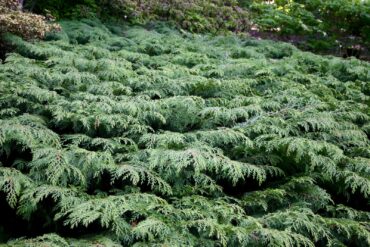
Microbiota Decussata
- Pronunciation: Mi-kro-bi-O-ta day-ku-SA-ta
- Light: Full sun to bright shade
- Soil: Moist, well-drained, somewhat fertile
- Height: 18 inches
- Width: 7 to 8 feet
Initially from a minimal area in Eastern Siberia, Microbiota decussata grows as if it’s right at home in our maritime climate. Hotter regions have conifer-envy since this shrub can’t take the heat. In our gardens, it requires supplemental watering during our drought.
A large cover of Microbiota decussata grows at the Rhododendron Species Foundation Garden in Federal Way. Handsome, arching branches filled with branchlets of flat sprays covered in soft, green needles of this sprawling shrub gracefully nod over the ground. During the winter months, the foliage turns bronze-purple in response to the cold.
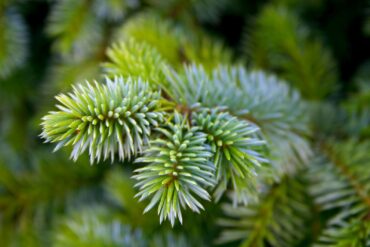
Picea Sitchensis ‘Papoose’
- Pronunciation: PIE-see-a sit-KEN-sis
- Light: Full sun
- Soil: Moist, well-drained, slightly acidic
- Height: 4 to 6 feet
- Width: 4 to 6 feet
Even though the Sitka spruce is the largest spruce species in North America, there are smaller versions of our giant spruce. Discovered growing in a forest on Vancouver Island in British Columbia, Picea sitchensis ‘Papoose,’ a dwarf Sitka spruce, starts its young life as a globe.
Eventually, a central leader forms and the small tree’s shape goes pyramidal. It only grows 1 1/2 inches a year, so don’t expect 6-foot pyramidal spruce anytime soon. The green needles have a two-tone effect with silvery-blue undersides.
Adapted to container growing, they can stay confined in a container for many years. Growing in the garden, the small tree will add fine textural effects to the landscape.
Site this spruce away from walkways, as brushing up against it with bare legs is a prickly experience.
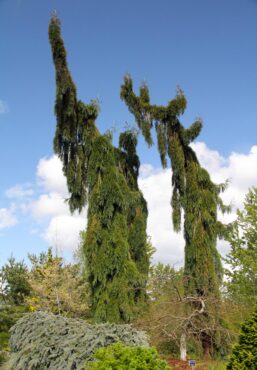
Sequoiadendron Giganteum ‘Pendulum’
- Pronunciation: See-kwoy-uh-DEN-dron jye-gan-TEE-um pen-DOO-luhm
- Light: Full sun
- Soil: Moist, well-drained
- Height: 25 feet
- Width: 3 to 4 feet
Some of the most massive trees in the world are the Sequoiadendrons. In California’s Sierra Nevada mountains, one specimen is over 3,000 years old. From this species comes a pillar tree much more suitable for gardens, Sequoiadendron giganteum ‘Pendulum.’
If you ever see a weeping Sierra redwood, you won’t soon forget it. Its pendulous growth makes some people affectionately call it the Dr. Seuss tree. Some branches grow downward and parallel to the trunk, while others grow upright and lean one way or another. Then dip down and grow upright again. The tree will sometimes grow multiple leaders.
Whatever garden it grows in, this pendulous conifer will become a focal point. It doesn’t need much room at its base but will grow tall and add exciting effects to the skyline.
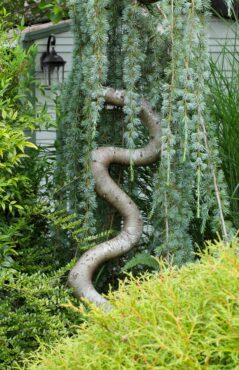
Cedrus Atlantica ‘Glauca Pendula’
- Pronunciation: SAY-drus at-LAN-ti-ka
- Light: Full sun
- Soil: Well-drained
- Height: 40 feet
- Width: 3 to 12 feet
The unique form of this Atlas cedar is perfect for those who like to make a tree bend to their will. They are trained to form archways or as espalier. Many are trained on horizontal poles or an ugly chain link to cover a fence. Others are trained to be serpentine — bent in a new direction every year. As a bonsai subject, it’s a popular choice for making a living sculpture.
The branches are clothed in powdery-blue needles. The conifer needs support while young. Growing up to 16 inches a year and reaching 8 to 10 feet in 10 years, it eventually matures at 60 feet tall by 40 feet wide.
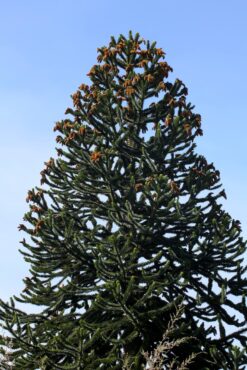
Araucaria Araucana
- Pronunciation: Air-ah-KAIR-ee-uh air-ah-KAY-nuh
- Light: Full sun
- Soil: Moist, well-drained
- Height: 30 feet
- Width: 20 feet
Ever wonder why this tree is commonly called the monkey puzzle tree? No monkeys live where the conifer comes from — Chile and Argentina. In England in 1834, the tale goes that barrister Charles Austin found the needles to be quite sharp and said, “Climbing it would be a puzzler for a monkey.” A common name was born.
No one ever accused this tree of being average — everything about it is unusual. For instance, the cones. When the tree matures, the cones become pretty significant. At 5 to 8 inches long, they weigh in at 10-15 pounds. It’s a good thing the cones fall apart while still on the tree; otherwise, those seed harbingers would be a hazard to anything below.
Even though you don’t have to worry about a large cone falling on your head, the needles will take any opportunity to impale you, as Austin found out way back when.
There are many of these architectural specimens growing around the Puget Sound region. In their native haunts, these conifers are endangered.
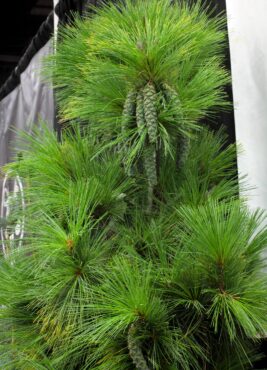
Pinus Schwerinii ‘Wiethorst’
- Pronunciation: PI-nus
- Light: Full sun
- Soil: Well-drained
- Height: 5 feet
- Width: 3 feet
The dwarf Schwerin’s pine came out of Germany, where it was discovered as a witch’s broom. The pine is a slow-growing dwarf pine that takes on a symmetrical, pyramidal shape. When young, it produces large, resinous cones that are nearly as big as the conifer. The long blue-green needles give it a soft look.
What’s a Conifer?
Conifers don’t bear flowers or have seeds surrounded by fruit like an angiosperm, so these trees became classified as gymnosperm (no flowers or fruit). That isn’t the end. As in anything in the universe, there are exceptions to any rule.
For the most part, a conifer has needles and bears cones. However, some trees bear cones and are not classified as conifers. Conifers are thought to be evergreen, yet some shed their entire needles every fall, such as larch (Larix), the giant sequoia (Sequoiadendron), redwood (Sequoia) and dawn redwood (Metasequoia).






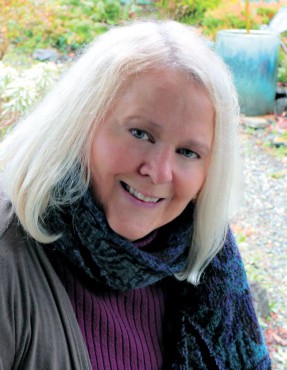

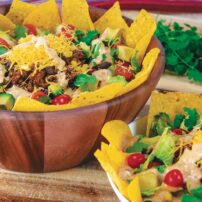
























Comments